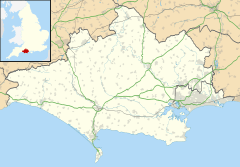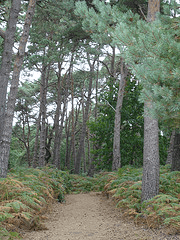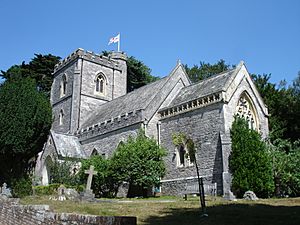Brownsea Island facts for kids
Quick facts for kids Brownsea Island |
|
|---|---|
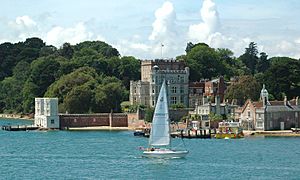 The castle and piers on Brownsea Island |
|
| OS grid reference | SZ019879 |
| Civil parish | |
| Unitary authority |
|
| Ceremonial county | |
| Region | |
| Country | England |
| Sovereign state | United Kingdom |
| Post town | POOLE |
| Postcode district | BH13 |
| Dialling code | 01202 |
| Police | Dorset |
| Fire | Dorset |
| Ambulance | South Western |
| EU Parliament | South West England |
| UK Parliament |
|
Brownsea Island, once known as Branksea, is the largest island in Poole Harbour in Dorset, England. The National Trust owns the island. The northern part is looked after by the Dorset Wildlife Trust.
Most of Brownsea Island is open to visitors. It has forests, open heathland, and lots of different wildlife. You can also enjoy amazing views of Poole Harbour and the Isle of Purbeck.
In 1907, a special camp was held on the island. This camp led to the start of the worldwide Scout movement a year later. You can get to the island by public ferry or private boat. In 2017, over 133,000 people visited Brownsea Island. The island's name likely comes from an old Anglo-Saxon phrase meaning "Brūnoc's island."
Contents
Discovering Brownsea Island's Geography
Brownsea Island is located in Poole Harbour, right across from the town of Poole in Dorset, England. It is the biggest of eight islands in the harbour.
You can reach the island by public ferry or your own boat. There is a wharf and a small dock near the main castle. The island is about 1.5 miles (2.4 km) long and 0.75 miles (1.2 km) wide. It covers about 500 acres (200 hectares) of woodland, heathland, and salt-marsh.
The National Trust owns almost the entire island. Only the church and a few other buildings are managed by other groups. Most buildings are close to the small landing stage.
The northern part of the island is a nature reserve. It is managed by the Dorset Wildlife Trust. This area is an important home for many birds. Public access to this part is limited. A small area in the southeast, including Brownsea Castle, is rented by the John Lewis Partnership. They use it as a holiday hotel for their staff, so it is not open to the public.
Wildlife and Nature on Brownsea Island
Brownsea Island formed from sand and mud banks in the shallow harbour. Over time, soil developed, allowing different ecosystems to grow.
The Dorset Wildlife Trust manages the nature reserve on the island. This reserve includes a salty lagoon and a wooded area. Other habitats on the island include salt marsh, reedbed, and two freshwater lakes. There are also different types of forests, like alder carr and conifer and deciduous woodlands.
In the past, non-native plants like rhododendrons were brought to the island. However, the trusts have worked to clear many of these areas. The entire island is a special protected area called a Site of Special Scientific Interest.
Amazing Animals of Brownsea Island
Brownsea Island is one of the few places in southern England where native red squirrels still live. This is mainly because non-native grey squirrels have never been introduced here. The red squirrels on Brownsea are unique. They are the only known group in the UK to carry a specific bacteria. This bacteria is related to the one that causes leprosy in humans.
The island also has a small group of beautiful peacocks. There is a heronry on the island, where both grey herons and little egrets build their nests.
A large number of non-native sika deer live on the island. In the past, there were too many deer. They ate too much vegetation, damaging trees and plants. To protect the island's plants and other animals like red squirrels, some areas have been fenced off.
The lagoon is famous for its large numbers of common terns and sandwich terns in summer. In winter, a very large flock of avocets gathers here. More than half of all avocets in Britain, over 1500, can be found on Brownsea Island during winter.
Some old stonework and statues on the island are home to a special Mediterranean land snail called Papillifera bidens.
Brownsea Island's Past
Early Days of Brownsea Island
The first records of people living on Brownsea Island date back to the 9th century. Monks from Cerne Abbey built a small chapel and a hermitage there. The chapel was for St Andrew. A hermit lived on the island, possibly helping sailors in Poole Harbour.
In 1015, Canute led a Viking raid. He used Brownsea as a base to attack Wareham and Cerne Abbey. In the 11th century, a man named Bruno owned the island. He was the Lord of the Manor of Studland. After his invasion, William the Conqueror gave Studland, including Brownsea, to his half-brother.
In 1154, King Henry II gave the Abbot of Cerne the right to claim items from shipwrecks on the island. The abbey continued to control Brownsea for the next 350 years.
Tudor Times and Civil War on Brownsea
After the Dissolution of the Monasteries, the King took control of Brownsea. Henry VIII understood how important the island was for protecting the entrance to the growing port of Poole. In 1547, a blockhouse was built on the island to defend against invaders. This building became known as Brownsea Castle.
Over the next centuries, many different owners had the island. In 1576, Queen Elizabeth I gave Brownsea to Sir Christopher Hatton. During the English Civil War, Poole supported Parliament. They put soldiers in Brownsea Castle. Colonel Thomas Pride, a famous military leader, was stationed on the island in 1654.
Sir Robert Clayton, a rich merchant and Lord Mayor of London, bought the island in the mid-1650s. After he died in 1707, the island was sold to William Benson. He was a Member of Parliament and an architect. He turned the castle into a home and brought many different types of trees to the island.
Brownsea's Industrial Dreams
In 1765, Sir Humphrey Sturt, a local landowner, bought the island. His sons later inherited it. Sturt made the castle bigger and spent a lot of money on the island's gardens. Sir Augustus John Foster, a retired diplomat, bought the island in 1840. He passed away on Brownsea Castle in 1848.
In 1852, Brownsea was sold for £13,000. It was bought by William Waugh, a former army Colonel. He believed he could use the white clay on the island to make high-quality porcelain. A three-story pottery factory was built in the southwest of the island. A tramway was built to move clay from pits in the north.
Waugh hoped the clay would be as good as clay from nearby Furzebrook. But it was only good for making things like pipes and toilets. The company hired over 200 people. However, by 1887, the business closed because of low demand and the poor quality of the clay.
You can still see signs of these activities today, like old building foundations and pottery pieces. Waugh also built more buildings on the island. He created the now ruined village of Maryland, named after his wife. He also added a new gatehouse and tower in the Tudor style.
Waugh also paid for a new pier with castle-like watch towers. Another big project was building St Mary's Church in the Gothic style. It was also named after his wife. Construction finished in 1854. Inside the church, there is a monument to Waugh and the tomb of a later owner, Charles van Raalte. Part of the church is dedicated to the Scouting movement. Flags from the Scout and Girl Guide movements hang near the main altar.
After getting into a lot of debt, the Waughs left for Spain. Creditors took over the island and sold it in 1873 to George Cavendish-Bentinck. He brought Jersey cows to Brownsea and expanded farming on the island. He also filled the island with several Italian Renaissance sculptures. Some of these still decorate the church and the quay.
The 1881 census showed 270 people living on the island. Most of them worked at the pottery factory. After Cavendish-Bentinck died, the island was sold to Kenneth Robert Balfour in 1891. The castle caught fire in 1896 after electric lighting was installed. It was rebuilt, and in 1901, Balfour put the island up for sale.
Brownsea Island in the 20th Century
The island was bought by a rich stockbroker named Charles van Raalte. He used it as a holiday home. During this time, the castle was fixed up and hosted famous visitors like Guglielmo Marconi. Robert Baden-Powell, a friend of the van Raaltes, held an experimental camp for boys on the island in the summer of 1907.
Brownsea was mostly self-sufficient, with a vegetable garden and dairy cows. Many pottery workers stayed on the island after the factory closed. They farmed and worked for the owners. Charles van Raalte died in Calcutta in 1908. His wife eventually sold the island in 1925.
In 1927, Mary Bonham-Christie bought it for £125,000. She was a private person and told most of the island's residents to move to the mainland. Much of the island was left empty and slowly returned to its natural state of heath and woodland. In 1934, a wild fire caused a lot of damage. It burned for a week. Most of the island turned to ashes. Buildings in the east were saved only because the wind changed direction. After this event, Bonham-Christie banned all public access to the island for the rest of her life.
During the Second World War, large flares were placed on the west end of the island. These were meant to trick German bombers away from Poole Harbour. This trick saved Poole and Bournemouth from thousands of German bombs. However, the deserted village of Maryland was destroyed.
In April 1961, Bonham-Christie died at 98 years old. Her grandson gave the island to the Treasury to pay her death duties. Local conservationist Helen Brotherton started a campaign. She worried the island might be sold to developers. Her goal was to buy the island to protect its nature.
The National Trust agreed to take care of the island if enough money was raised. In 1962, they bought Brownsea for £100,000. Work began to get the island ready for visitors. Paths were cleared through areas overgrown with rhododendrons. Firebreaks were made to stop another fire like the one in 1934.
The Dorset Wildlife Trust leased a nature reserve on the north of the island. The Scout and Guide Movements were allowed to return. The castle was renovated and rented to the John Lewis Partnership for their staff hotel. The island opened to the public in May 1963. Olave, Lady Baden-Powell, the Chief Guide, led the opening ceremony. Members of the 1907 camp also attended. Soon after opening, Brownsea Island attracted over 10,000 visitors a year. Today, larger boats mean the island welcomes about 110,000 visitors annually.
Brownsea Island Today
Since 1964, Brownsea Island has hosted the Brownsea Open Air Theatre. They perform plays by William Shakespeare every year. The island has a visitor centre and a museum. These show the island's history. There is also a shop and a cafe. One holiday cottage is available on the quay. At the Scout camp on the southwest of the island, there is an outdoor centre and a trading post shop. This shop focuses on the Scout movement.
The Dorset Wildlife Trust works on the island from The Villa. This building used to be the island vicarage. The island has one post box that is emptied daily. In October 2008, the island was shown on BBC One's Autumnwatch programme.
There is an annual swim around the island. It is about 4.5 miles (7.2 km) long. The RLSS Poole Lifeguards organize this event.
The Birthplace of Scouting
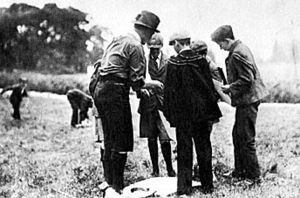
From August 1 to August 8, 1907, Robert Baden-Powell held an experimental camp on Brownsea Island. He wanted to test his ideas for Scouting. He brought together 21 boys from different backgrounds. Some were from London schools, and others were from local Boys' Brigade units.
The boys spent a week camping. They learned about camping, observation, woodcraft, and lifesaving. They also learned about being chivalrous and patriotic. The camp was a success. In 1908, Baden-Powell published his first book about Scouting, Scouting for Boys. The international Scouting movement quickly grew from there.
Boy Scouts continued to camp on the island until the 1930s. At that time, the island's owner banned all public access. After the National Trust took over the island, a permanent 20-hectare (49-acre) Scout camp site opened in 1963. Olave Baden-Powell opened it.
In August 2007, 100 years after the first camp, Brownsea Island was the center of worldwide celebrations for the centenary of Scouting. Four camps were set up on the island. One was a copy of the original 1907 camp. Hundreds of Scouts and Girl Guides from 160 countries came to the island to celebrate.
Brownsea Island's Twin
Brownsea Island is twinned with:
See also
 In Spanish: Isla de Brownsea para niños
In Spanish: Isla de Brownsea para niños


